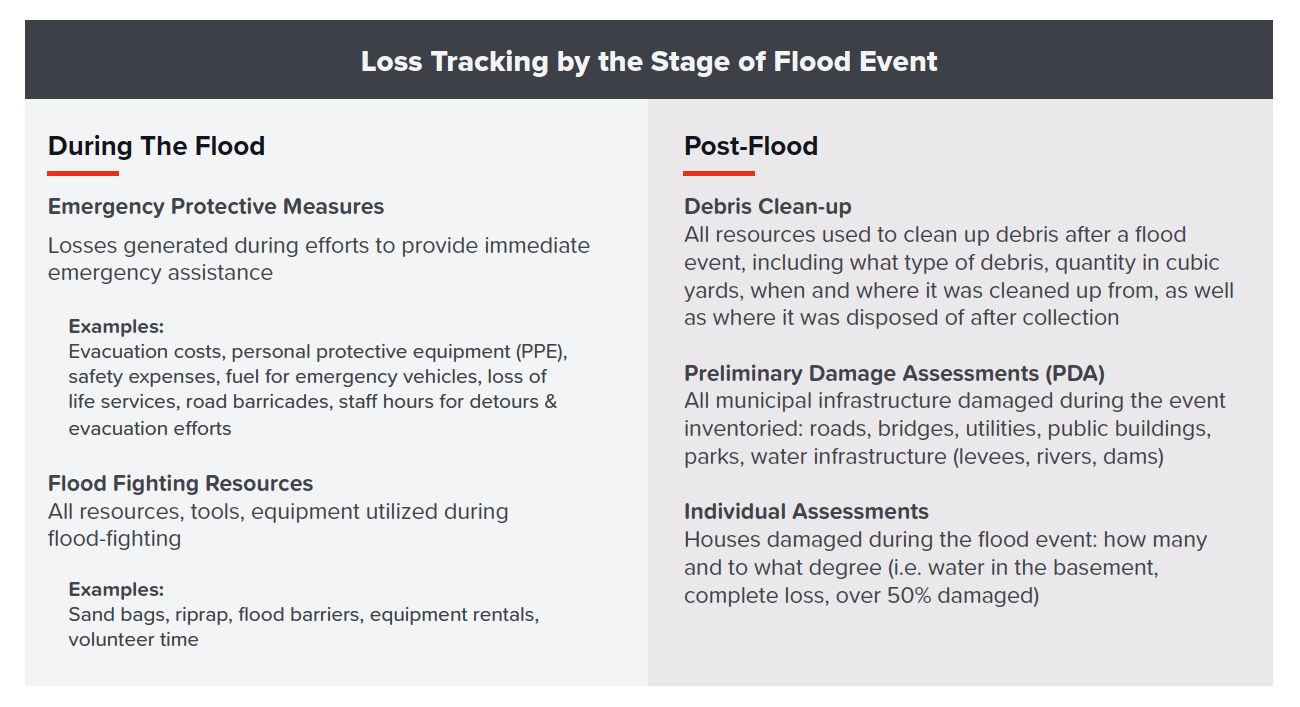Spring is here, and so too is flood season. Last spring’s flooding was a harsh reminder of the kind of damage that disasters can inflict on a community. While the road to restoration can be long and hard, federal and state disaster relief programs provide an opportunity to expedite the process. To receive the maximum funding available, communities must work to track and document all losses accrued during a disaster; a process that can be tedious and a bit overwhelming.
To help you begin the process, here are some of our top tips for tracking disaster losses before, during, and after a flood event.
Document Current Condition
It is a best practice to document site, equipment, and infrastructure conditions on a regular basis (we recommend annual documentation). The ability to show pre-disaster conditions can make the process of recuperating local losses less challenging. This process may include the following strategies: capturing photos of current conditions including time and date stamp; descriptions and documentation of improvements that are not visible; valuations of assets; and video documentation with spoken narration of what is being recorded if possible.
Declare a State of Emergency
Either as the disaster is unfolding or immediately following the event designated officials should assess the impacts and determine if a local emergency declaration is merited. Last year we learned that it was important to declare a state of emergency as quickly as was practical. The local emergency declaration activates eligibility for special funding mechanisms that can be created specifically to support disaster relief.
Prioritize Proactive Documentation and Capturing Photos of Damages
Once flooding has subsided, you will need to provide FEMA with documentation of what was damaged and the extent of loss. Rather than waiting for infrastructure field inspections post-flood, proactively capturing images and other documentation (labor hours, material) for damages during the response phase and early portions of the recovery phase can give you a major leg-up when it comes time to begin reporting the entirety of damages associated with a flood event.
Communicate with your staff as early as possible to capture images, videos, and notes about areas that have been damaged by flooding. In this case, a picture is truly worth a thousand words as pictures can help FEMA officials work to validate your community’s damage claims quickly.
![]()
Hot Tip: Shared Team Folders
If you do not already have one, create a shared folder system for staff members and volunteers to upload and store all damages media in an organized fashion. This will save you a major headache down the road when trying to locate specific photos.
Compile and Track All Expenses Related to the Event
Emergency Protective Measures accomplished within the first 72 hours of an emergency flood event can be almost completely recovered through FEMA and other disaster relief funding mechanisms. As such, it is in your best interest to create a list, paired with documentation, of all costs accrued as a result of the flood during this time. These costs can range from supplies and resources needed to fight flooding, to the administrative staffing costs for keeping track of the accumulated damages from the event.
Examples of costs eligible for coverage by disaster relief assistance include:
-
flood-fighting supplies and equipment labor hours associated with relief efforts
-
contractors hired during flooding-fighting efforts
-
equipment rental fees
-
administrative assistance during a flood event
To get started tracking your losses, use the FEMA Finance sheet.
Track Losses by Following the Chronological Arc of the Flood Event
Rather than tracking disaster losses for a flood event as a whole, we recommend tracking them in the order in which they were incurred. This will help your team paint a more detailed picture of total losses associated with the event and provide a solid starting point to begin the work. For flood events, this means starting with the losses associated with providing emergency protective measures first, as they would be the first expenses incurred in the event.

Reach Out for Help
By nature, communities seek disaster relief assistance following high-stress emergency situations. There are many decisions to make, and not much time to make them. Although, your community likely has an emergency plan in place, don’t be afraid to reach out for help should you need it. Reaching out to clarify questions early will save your community from missing out on disaster relief funds in the future. Every county has an emergency management professional assigned to assist communities through this disaster process. Reach out to them and the NEMA staff for direct assistance as you pave the way through the response and recovery process.

